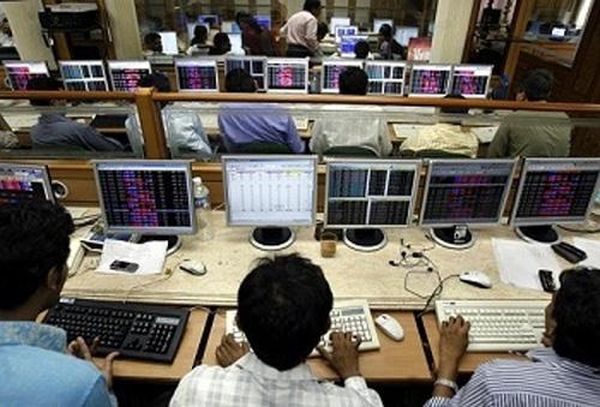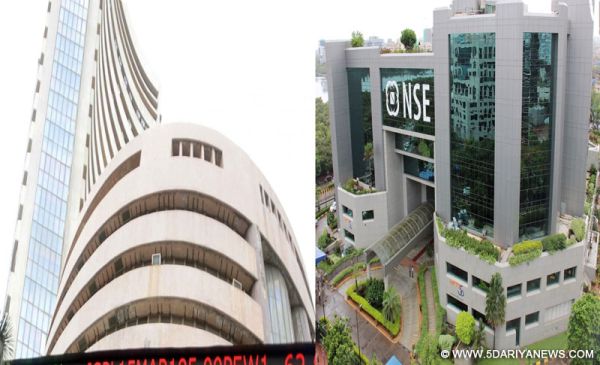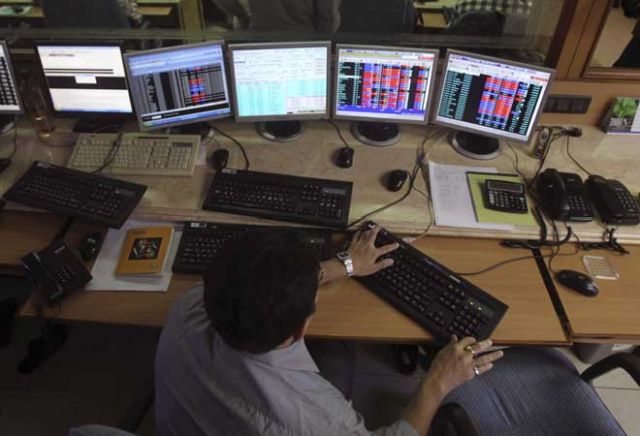
by admin | May 25, 2021 | Economy, Markets, News, Politics
 Mumbai : Cheering the Bharatiya Janata Party’s (BJP) win in the Gujarat and Himachal Pradesh assembly polls and with a surge in automobile stocks, the key Indian equity indices — the BSE Sensex and the NSE Nifty50 — rose to new closing highs on Tuesday.
Mumbai : Cheering the Bharatiya Janata Party’s (BJP) win in the Gujarat and Himachal Pradesh assembly polls and with a surge in automobile stocks, the key Indian equity indices — the BSE Sensex and the NSE Nifty50 — rose to new closing highs on Tuesday.
The barometer 30-scrip Sensitive Index (Sensex) of the BSE provisionally closed at a new high of 33,836.74 points — up 235.06 points or 0.70 per cent from its previous close — surpassing its previous closing high of 33,685.56 points recorded on November 3.
The BSE market breadth was bullish — 1,875 advances and 804 declines.
Similarly, the wider Nifty50 of the National Stock Exchange soared by 83.45 points or 0.80 per cent to a new high of 10,472.20 points on a closing basis, crossing its previous closing high of 10,452.50 points scaled on November 3.
On Monday, the key indices closed with gains after swinging from the extreme negative to the positive.
The NSE Nifty50 rose by 55.50 points or 0.54 per cent to close at 10,388.75 points, while the BSE Sensex closed at 33,601.68 points — up 138.71 points or 0.41 per cent — from its previous close.
—IANS

by admin | May 25, 2021 | Branding, Business, Large Enterprise, Markets, Technology
 By Faisal Kawoosa,
By Faisal Kawoosa,
The year 2017 is likely to be remembered as the year of transition. And 2018 is going to be the year of experiments for the smartphone industry — marking the start of a second era of handsets for Indian consumers.
Handset players will attempt various strategies as they have different agendas to drive and achieve distinct goals. There can be no similar measures working for all the handset makers; however, there are certain focal points for the industry to zero in on to succeed.
Some of the major recommendations for the industry for the year ahead would be:
Premium presence: There was a time when, to become an impactful brand, a smartphone player had to have a portfolio in the under Rs 10,000 price category to essentially cater to new smartphone users.
As the market grows towards upgrades and replacements, it is essential to have a portfolio in the premium category as well. The success in the premium segment will have a direct bearing on the profitability of the brand as well as its overall market standing. The premium segment is the area that home-grown brands have to focus on.
Bundle up: To counter Jio, the existing players have started joining hands with smartphone makers to offer devices almost at prices in the vicinity of 4G feature phones.
While it gives some respite to weakening smartphone brands as, through operator support, they could ensure some volumes, the quality at the entry level has always been questionable. The operators who are otherwise facing criticism from the ecosystem, including the government, regarding call drops, will have to be careful to ensure that such smartphones don’t add new subscribers to the base who are soon dissatisfied.
Operators, especially the incumbents, must look at the next price-level band. There could be some support from the component ecosystem as well, especially the chipset makers.
Telecom: This needs to be now seen in a wider perspective. The technology that lies inside a smartphone could be used to create several other products that become “smart” and “connected”. To gain substantially, it should be a critical long-term strategy point for the Indian brands. They should, in fact, collaborate to look at this future opportunity. Also, the local brands must explore gaming consoles and other devices that can be explored within the same ecosystem.
Hybrid channels: Offline or online? The answer would be both. Exclusive or multi-brand? A complicated question. We have seen the trend triggered by Xiaomi — and adopted mby Oppo as well: Strong Chinese brands will go for their own exclusive retail stores. Indian brands would, however, prefer the multi-brand strategy as they don’t have the resources to expand retail exclusively.
Another way would be hybrid channels where one can take advantage of online selling while, at the same time, being assured of a physical connect with prospective buyers, especially in the rural and remote urban markets. One such channel worth exploring would be the Common Service Centres (CSCs) across the country. That would be RaaS (Retail-as-a-Service) model for the handset makers.
Purpose-built smartphones: The era of exploring the device is over for a substantial number of users and now the use cases are pretty much defined. From the hardware perspective, the smartphone is more or less commoditised and the “solutioning” around it would matter a lot and bring in premium value. The handset makers need to identify considerable opportunity segments and build a smartphone catering to those. This would put a brake on the trend of loading devices with higher specifications which go unutilised as the user may not need them. The value-add should come from handset makers and experts in the field.
Realistically futuristic: One of the challenges with brands selling smartphones is showcasing the future of technology to keep the market excited. However, while doing so, they end up showcasing technologies that are at least a decade ahead. This could backfire on the brand. The entire R&D effort can be jeopardised, creating an imbalance between resources and effort.
It is high time the industry started identifying the challenges, understanding which of these could be addressed quickly and then focusing experiments on them. There is no single set of solutions cutting across all the brands and replicating the successful strategy of one brand would not work for another. The experiments next year would have to be focused and result-oriented.
(Faisal Kawoosa is the General Manager-Research & Consulting with CyberMedia Research [CMR]. His core areas of research include Telecommunications and ESDM. The views expressed here are personal. He can be contacted at releases@cmrindia.com)
—IANS

by admin | May 25, 2021 | Economy, Markets, News, Politics
 Mumbai : Riding on the exit polls outcome which predicted a BJP win in Gujarat and Himachal Pradesh assembly elections, the two key indices of the domestic markets extended gains for the second consecutive session on Friday.
Mumbai : Riding on the exit polls outcome which predicted a BJP win in Gujarat and Himachal Pradesh assembly elections, the two key indices of the domestic markets extended gains for the second consecutive session on Friday.
According to market observers, the key equity indices — which surged to higher levels supported by healthy buying in metals, consumer durables and auto stocks and a strong rupee — trimmed some gains on the back of weak global markets.
On a closing basis, the wider Nifty50 of the National Stock Exchange (NSE) rose by 81.15 points or 0.79 per cent to 10,333.25 points.
The barometer 30-scrip Sensitive Index (Sensex) of the BSE closed at 33,462.97 points — up 216.27 points or 0.65 per cent — from its previous close.
However, the BSE market breadth was bearish — 1,572 declines and 1,049 advances.
In the broader markets, the S&P BSE mid-cap index was up by 1 per cent and the small-cap index by 1.38 per cent.
“Markets ended higher on Friday on the back of the outcome of Gujarat and Himachal Pradesh exit polls. The markets opened on a strong note in the morning session and then traded in a range for the rest of the day,” Deepak Jasani, Head, Retail Research, HDFC Securities, told IANS.
“Some selling was seen towards the close on the back of weakness in the global equity markets,” he added.
On the currency front, the Indian rupee strengthened by 30 paise to close at 64.04 against the US dollar from its previous close at 64.34.
Provisional data with the exchanges showed that foreign institutional investors sold scrips worth Rs 921.03 crore while domestic institutional investors purchased stocks worth Rs 635.44 crore.
Vinod Nair, Head of Research, Geojit Financial Services, said: “Market rallied with the ecstasy of Gujarat exit poll result which suggested a clear victory for the ruling party. Underlined disruptions on government reforms have not influenced the poll.
“Metals gained its sheen after the recent correction, while bank nifty and auto outperformed the main index as investors used the advantage of bargaining opportunity,” he added.
All the sub-indices of the BSE ended in the green barring the S&P BSE telecom index, which was down 7.98 points.
Sector-wise, the BSE S&P metal index surged by 379.91 points, followed by consumer durables index by 359.02 points and auto index by 335.21 points.
Major Sensex gainers on Friday were: Mahindra and Mahindra, up 3.56 per cent at Rs 1,482.65; Coal India, up 3.02 per cent at Rs 271.05; Dr. Reddy’s Lab, up 2.52 per cent at Rs 2,372; HDFC Bank, up 1.95 per cent at Rs 1,873.05; and Adani Ports, up 1.75 per cent at Rs 401.95.
Major Sensex losers were: Cipla, down 2.53 per cent at Rs 575.85; ONGC, down 0.87 per cent at Rs 182.85; Asian Paints, down 0.45 per cent at Rs 1,119.95; Tata Consultancy Services, down 0.42 per cent at Rs 2,547.85; and State Bank of India, down 0.41 per cent at Rs 312.75.
—IANS

by admin | May 25, 2021 | Economy, Markets, News
 Mumbai : Shedding the day’s entire losses, key Indian equity indices on Thursday provisionally closed on a higher note lifted by healthy buying in healthcare, banks and auto stocks.
Mumbai : Shedding the day’s entire losses, key Indian equity indices on Thursday provisionally closed on a higher note lifted by healthy buying in healthcare, banks and auto stocks.
Top gainers on the BSE market breadth were Dr. Reddy’s Lab, Cipla, ITC, Mahindra and Mahindra and Axis Bank. IT major Tata Consultancy Services (TCS) remained the top loser with a loss of 2.62 per cent.
The wider Nifty50 of the National Stock Exchange (NSE) edghed higher by 59.15 points or 0.58 per cent to provisionally close (at 3.30 p.m.) at 10,252.10 points.
The barometer 30-scrip Sensitive Index (Sensex) of the BSE, which opened at 33,114.69 points, closed at 33,246.70 points — up 193.66 points or 0.59 per cent — from its previous close.
The Sensex touched a high of 33,321.52 points and a low of 32,886.93 points during the intra-day trade so far.
However, the BSE market breadth was bearish — 1,528 declines and 1,095 advances.
On Wednesday, the key indices ended a volatile trade session in the red as investors booked profits.
The NSE Nifty50 fell by 47.20 points or 0.46 per cent to close at 10,192.95 points while the 30-scrip Sensitive Index (Sensex) of the BSE closed at 33,053.04 points — down 174.95 points or 0.53 per cent.
—IANS

by admin | May 25, 2021 | Economy, Markets, News
 Mumbai : Key Indian equity indices on Tuesday closed on a lower note — snapping a three-day gaining streak — as rising crude oil prices, along with negative global cues and profit booking in rate-sensitive stocks, hampered investors’ risk-taking appetite.
Mumbai : Key Indian equity indices on Tuesday closed on a lower note — snapping a three-day gaining streak — as rising crude oil prices, along with negative global cues and profit booking in rate-sensitive stocks, hampered investors’ risk-taking appetite.
According to market observers, investors traded with caution ahead of the release of macroeconomic data points — the Consumer Price Index (CPI) and Index of Industrial Production (IIP) data — to be released later during the day.
On a closing basis, the wider Nifty50 of the National Stock Exchange (NSE) edged lower by 82.10 points or 0.80 per cent to 10,240.15 points.
The barometer 30-scrip Sensitive Index (Sensex) of the BSE closed at 33,227.99 points — down 227.80 points or 0.68 per cent — from its previous close.
The BSE market breadth was bearish — 1,701 declines and 982 advances.
“Markets corrected on Tuesday after three sessions of gains. The weakness came on the back of surging crude oil prices and negative Asian markets,” Deepak Jasani, Head, Retail Research, HDFC Securities, told IANS.
“The Sensex and Nifty traded in the negative territory throughout the session after a weak opening. Index heavyweights ITC, Tata Consultancy Services (TCS), Larsen and Toubro, HDFC Bank and Coal India dragged the indices lower,” he added.
In the broader markets, the S&P BSE mid-cap index closed lower by 1.01 per cent and the small-cap index by 0.68 per cent.
On the currency front, the rupee weakened by four paise to close at 64.40 against the US dollar from its previous close at 64.36.
“Indian equities turned cautious as investors looked forward for macro-economic data, IIP and retail inflation to be released post market hours. Investors booked profits and awaited for more clarity,” Dhruv Desai, Director and Chief Operating Officer of Tradebulls, told IANS.
Provisional data with the exchanges showed that foreign institutional investors invested in scrips worth Rs 843.20 crore while domestic institutional investors sold stocks worth Rs 853.67 crore.
Vinod Nair, Head of Research, Geojit Financial Services, said: “Rate sensitive stocks underperformed ahead of today’s economic data – CPI inflation and IIP.
“Mixed trend in global market ahead of two days of US Fed meet also slowed down the domestic sentiment.”
All the 19 sub-indices of the BSE ended in the negative territory, led by S&P BSE banking index which dipped by 293.64 points, followed by automobile index by 201.92 points and capital goods index by 171.59 points.
Major Sensex gainers on Tuesday were: Dr. Reddy’s Lab, up 2.83 per cent at Rs 2,255.60; Adani Ports, up 2.46 per cent at Rs 401.60; ONGC, up 2.26 per cent at Rs 182.95; Lupin, up 0.87 per cent at Rs 845; and Infosys, up 0.76 per cent at Rs 1,011.10.
Major Sensex losers were: Coal India, down 2.45 per cent at Rs 263.25; Cipla, down 2.17 per cent at Rs 590.75; Hero MotoCorp, down 1.98 per cent at Rs 3,444.95; TCS, down 1.58 per cent at Rs 2,614.15; and Tata Steel, down 1.54 per cent at Rs 689.20.
—IANS

 Mumbai : Cheering the Bharatiya Janata Party’s (BJP) win in the Gujarat and Himachal Pradesh assembly polls and with a surge in automobile stocks, the key Indian equity indices — the BSE Sensex and the NSE Nifty50 — rose to new closing highs on Tuesday.
Mumbai : Cheering the Bharatiya Janata Party’s (BJP) win in the Gujarat and Himachal Pradesh assembly polls and with a surge in automobile stocks, the key Indian equity indices — the BSE Sensex and the NSE Nifty50 — rose to new closing highs on Tuesday.


